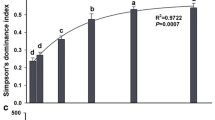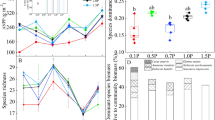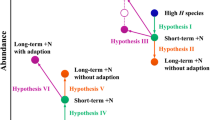Abstract
Global nitrogen (N) deposition generally reduces ecosystem stability. However, less is known about the responses of ecosystem stability and its driving mechanisms under different N addition gradients. We conducted a four-year N addition experiment in an alpine meadow, using six levels of N addition rates (0, 2, 4, 8, 16, 32 g N m−2 year−1) to examine the effects of N addition on plant community biomass stability and the underlying mechanisms. We found that the stability of ecosystem aboveground net primary productivity (ANPP) decreased linearly with increasing N addition rates, even though it had no effect on plant species richness at low N addition rates and significantly reduced species richness at high N addition rates. The most remarkable finding is that the main mechanism underlying ecosystem stability shifted with N addition rates. The decrease of common species stability contributed most to the reduction of plant community biomass stability under low N addition rates (N0–N4), whereas the decrease of species asynchrony contributed most to the reducing plant community biomass stability under high N addition rates (N8–N32). Our results indicate that species diversity was not a significant predictor of plant community biomass stability in this alpine meadow, which challenges the traditional knowledge. This study highlights the shifts of main mechanism regulating plant community biomass stability under different N addition rates, and suggests that continuous nitrogen deposition in the future may reduce ecosystem stability and potentially impeding the sustainable provision of ecosystem functions and services.





Similar content being viewed by others
Data Accessibility
Associated data are available in the supporting information.
References
Adler PB, Fajardo A, Kleinhesselink AR, Kraft NJ. 2013. Trait-based tests of coexistence mechanisms. Ecol Lett 16:1294–306.
Allan E, Weisser W, Weigelt A, Roscher C, Fischer M, Hillebrand H. 2011. More diverse plant communities have higher functioning over time due to turnover in complementary dominant species. Proc National Acad Sci United States America 108:17034–9.
Bai Y, Wu J, Clark CM, Naeem S, Pan Q, Huang J, Zhang L, Han X. 2010. Tradeoffs and thresholds in the effects of nitrogen addition on biodiversity and ecosystem functioning: evidence from inner Mongolia Grasslands. Global Change Biol 16:358–72.
Callaway RM, Brooker RW, Choler P, Kikvidze Z, Lortie CJ, Michalet R, Paolini L, Pugnaire FI, Newingham B, Aschehoug ET, Armas C, Kikodze D, Cook BJ. 2002. Positive interactions among alpine plants increase with stress. Nature 417:844–8.
Callaway RM, Walker LR. 1997. Competition and facilitation: a synthetic approach to interactions in plant communities. Ecology 78:1958–65.
Cardinale BJ, Gross K, Fritschie K, Flombaum P, Fox JW, Rixen C, Ruijven JV, Reich PB, Scherer-Lorenzen M, Wilsey BJ. 2013. Biodiversity simultaneously enhances the production and stability of community biomass, but the effects are independent. Ecology 94:1697–707.
Cardinale BJ, Wright JP, Cadotte MW, Carroll IT, Hector A, Srivastava DS, Loreau M, Weis JJ. 2007. Impacts of plant diversity on biomass production increase through time because of species complementarity. Proc National Acad Sci 104:18123–8.
Chen W, Zhang Y, Mai X, Shen Y. 2016. Multiple mechanisms contributed to the reduced stability of Inner Mongolia grassland ecosystem following nitrogen enrichment. Plant and Soil 409:283–96.
Cottingham KL, Brown BL, Lennon JT. 2001. Biodiversity may regulate the temporal variability of ecological systems. Ecol Lett 4:72–85.
Dijkstra FA, Carrillo Y, Blumenthal DM, Mueller KE, LeCain DR, Morgan JA, Zelikova TJ, Williams DG, Follett RF, Pendall E. 2018. Elevated CO2 and water addition enhance nitrogen turnover in grassland plants with implications for temporal stability. Ecol Lett 21:674–82.
Doak DF, Bigger D, Harding EK, Marvier MA, O’Malley RE, Thomson D. 1998. The statistical inevitability of stability-diversity relationships in community ecology. Am Naturalist 151:264–76.
Downing AL, Brown BL, Leibold MA. 2014. Multiple diversity–stability mechanisms enhance population and community stability in aquatic food webs. Ecology 95:173–84.
Galloway JN, Dentener FJ, Capone DG, Boyer EW, Howarth RW, Seitzinger SP, Asner GP, Cleveland CC, Green PA, Holland EA, Karl DM, Michaels AF, Porter JH, Townsend AR, Smarty CJVR. 2004. Nitrogen cycles: past, present, and future. Biogeochemistry 70:153–226.
Galloway JN, Townsend AR, Erisman JW, Bekunda M, Cai Z, Freney JR, Martinelli LA, Seitzinger SP, Sutton MA. 2008. Transformation of the nitrogen cycle: Recent trends, questions, and potential solutions. Science 320.
Gomez-Casanovas N, Hudiburg TW, Bernacchi CJ, Parton WJ, DeLucia EH. 2016. Nitrogen deposition and greenhouse gas emissions from grasslands: uncertainties and future directions. Global Change Biol 22:1348–60.
Gonzalez A, Loreau M. 2009. The causes and consequences of compensatory dynamics in ecological communities. Ann Rev Ecol Evol Syst 40:393–414.
Grime JP. 1998. Benefits of plant diversity to ecosystems: immediate, filter and founder effects. J Ecol 86:902–10.
Grman E, Lau JA, Schoolmaster DR Jr, Gross KL. 2010. Mechanisms contributing to stability in ecosystem function depend on the environmental context. Ecol Lett 13:1400–10.
Hautier Y, Seabloom EW, Borer ET, Adler PB, Harpole WS, Hillebrand H, Lind EM, MacDougall AS, Stevens CJ, Bakker JD, Buckley YM, Chu C, Collins SL, Daleo P, Damschen EI, Davies KF, Fay PA, Firn J, Gruner DS, Jin VL, Klein JA, Knops JM, La Pierre KJ, Li W, McCulley RL, Melbourne BA, Moore JL, O’Halloran LR, Prober SM, Risch AC, Sankaran M, Schuetz M, Hector A. 2014. Eutrophication weakens stabilizing effects of diversity in natural grasslands. Nature 508:521–5.
Hautier Y, Tilman D, Isbell F, Seabloom EW, Borer ET, Reich PB. 2015. Anthropogenic environmental changes affect ecosystem stability via biodiversity. Science 348:336–40.
Hector A, Hautier Y, Saner P, Wacker L, Bagchi R, Joshi J, Scherer-Lorenzen M, Spehn EM, Bazeley-White E, Weilenmann M, Caldeira MC, Dimitrakopoulos PG, Finn JA, Huss-Danell K, Jumpponen A, Mulder CPH, Palmborg C, Pereira JS, Siamantziouras ASD, Terry AC, Troumbis AY, Schmid B, Loreau M. 2010. General stabilizing effects of plant diversity on grassland productivity through population asynchrony and overyielding. Ecology 91:2213–20.
Hillebrand H, Bennett DM, Cadotte MW. 2008. Consequences of dominance: a review of evenness effects on local and regional ecosystem processes. Ecology 89:1510–20.
Humbert JY, Dwyer JM, Andrey A, Arlettaz R. 2016. Impacts of nitrogen addition on plant biodiversity in mountain grasslands depend on dose, application duration and climate: a systematic review. Global Change Biol 22:110–20.
Isbell F, Craven D, Connolly J, Loreau M, Schmid B, Beierkuhnlein C, Bezemer TM, Bonin C, Bruelheide H, de Luca E, Ebeling A, Griffin JN, Guo Q, Hautier Y, Hector A, Jentsch A, Kreyling J, Lanta V, Manning P, Meyer ST, Mori AS, Naeem S, Niklaus PA, Polley HW, Reich PB, Roscher C, Seabloom EW, Smith MD, Thakur MP, Tilman D, Tracy BF, van der Putten WH, van Ruijven J, Weigelt A, Weisser WW, Wilsey B, Eisenhauer N. 2015. Biodiversity increases the resistance of ecosystem productivity to climate extremes. Nature 526:574–7.
Jiang L, Pu Z. 2009. Different effects of species diversity on temporal stability in single-trophic and multitrophic communities. The American Naturalist 174:651–9.
Keitt TH. 2008. Coherent ecological dynamics induced by large-scale disturbance. Nature 454:331–4.
Leps J. 2004. Variability in population and community biomass in a grassland community affected by environmental productivity and diversity. OIKOS 107:64–71.
Leps J, Majekova M, Vitova A, Dolezal J, Bello Fd. 2018. Stabilizing effects in temporal fluctuations: management, traits, and species richness in high-diversity communities. Ecology 99:360–71.
Li G, Sun S. 2011. Plant clipping may cause overestimation of soil respiration in a Tibetan alpine meadow, southwest China. Ecol Res 26:497–504.
Loreau M, de Mazancourt C. 2008. Species synchrony and its drivers: neutral and nonneutral community dynamics in fluctuating environments. Am Naturalist 172:E48–66.
Loreau M, de Mazancourt C. 2013. Biodiversity and ecosystem stability: a synthesis of underlying mechanisms. Ecol Lett 16(Suppl 1):106–15.
Loreau M, Hector A. 2001. Partitioning selection and complementarity in biodiversity experiments. Nature 412:72–6.
Lü C, Tian H. 2007. Spatial and temporal patterns of nitrogen deposition in China: Synthesis of observational data. Journal of Geophysical Research 112.
Ma F, Song B, Quan Q, Zhang F, Wang J, Zhou Q, Niu S. 2020. Light competition and biodiversity loss cause saturation response of net primary productivity to nitrogen enrichment. Journal of Geophysical Research: Biogeosciences.
Ma F, Song B, Zhang F, Quan Q, Zhou Q, Niu S. 2018. Ecosystem Carbon Use Efficiency Is Insensitive to Nitrogen Addition in an Alpine Meadow. J Geophys Res Biogeosc 123:2388–98.
Ma Z, Liu H, Mi Z, Zhang Z, Wang Y, Xu W, Jiang L, He JS. 2017. Climate warming reduces the temporal stability of plant community biomass production. Nature Commun 8:15378.
Mulder CPH, Uliassi DD, Doak DF. 2001. Physical stress and diversity-productivity relationships_ The role of positive interactions. Proc National Acad Sci United States of America 98:6704–8.
Niu D, Yuan X, Cease AJ, Wen H, Zhang C, Fu H, Elser JJ. 2018. The impact of nitrogen enrichment on grassland ecosystem stability depends on nitrogen addition level. Sci Total Environ 618:1529–38.
Niu S, Wu M, Han YI, Xia J, Zhang ZHE, Yang H, Wan S. 2010. Nitrogen effects on net ecosystem carbon exchange in a temperate steppe. Global Change Biology 16:144–55.
Oliver TH, Isaac NJ, August TA, Woodcock BA, Roy DB, Bullock JM. 2015. Declining resilience of ecosystem functions under biodiversity loss. Nature Commun 6:10122.
Polley HW, Wilsey BJ, Derner JD. 2003. Do species evenness and plant density influence the magnitude of selection and complementarity effects in annual plant species mixtures. Ecol Lett 6:248–56.
Romanuk TN, Vogt RJ, Kolasa J. 2006. Nutrient enrichment weakens the stabilizing effect of species richness. OIKOS 114:291–302.
Sasaki T, Lauenroth WK. 2011. Dominant species, rather than diversity, regulates temporal stability of plant communities. Oecologia 166:761–8.
Sasaki T, Lu X, Hirota M, Bai Y, Allan E. 2019. Species asynchrony and response diversity determine multifunctional stability of natural grasslands. Journal of Ecology.
Song B, Sun J, Zhou Q, Zong N, Niu S. 2017. Initial shifts in nitrogen impact on ecosystem carbon fluxes in an alpine meadow: patterns and causes. Biogeosciences 14:3947–56.
Song L, Bao X, Liu X, Zhang F. 2012. Impact of nitrogen addition on plant community in a semi-arid temperate steppe in China. J Arid Land 4:3–10.
Steiner CF, Long ZT, Krumins JA, Morin PJ. 2005. Temporal stability of aquatic food webs: partitioning the effects of species diversity, species composition and enrichment. Ecol Lett 8:819–28.
Stevens CJ, Lind EM, Hautier Y, Harpole WS, Borer ET, Hobbie S, Seabloom EW, Ladwig L, Bakker JD, Chu C, Collins S, Davies KF, Firn J, Hillebrand H, Pierre KJL, Dougall AM, Melbourne B, McCulley RL, Morgan J, Orrock JL, Prober SM, Risch AC, Schuetz M, Wragg PD. 2015. Anthropogenic nitrogen deposition predicts local grassland primary production worldwide. Ecology 96:1459–65.
Suding KN, Collins SL, Gough L, Clark C, Cleland EE, Gross KL, Milchunas DG, Pennings S. 2005. Functional- and abundance-based mechanisms explain diversity loss due to N fertilization. Proc National Acad Sci United States of America 102:4387–92.
Tilman D. 1999. The ecological consequences of changes in biodiversity: A search for general principles. Ecology 80:1455–74.
Tilman D, Lehman CL, Bristow CE. 1998. Diversity-Stability Relationships: statistical Inevitability or Ecological Consequence? American Naturalist 151:277–82.
Tilman D, Reich PB, Knops J, Wedin D, Mielke T, Lehman C. 2001. Diversity and productivity in a long-term grassland experiment. Science 294:843–5.
Tilman D, Reich PB, Knops JM. 2006. Biodiversity and ecosystem stability in a decade-long grassland experiment. Nature 441:629–32.
Valone TJ, Hoffman CD. 2003. Population stability is higher in more diverse annual plant communities. Ecol Lett 6:90–5.
van Ruijven J, Berendse F. 2007. Contrasting effects of diversity on the temporal stability of plant populations. OIKOS 116:1323–30.
Wayne Polley H, Wilsey BJ, Derner JD. 2007. Dominant species constrain effects of species diversity on temporal variability in biomass production of tallgrass prairie. OIKOS 116:2044–52.
Wilsey BJ, Daneshgar PP, Hofmockel K, Polley HW. 2014. Invaded grassland communities have altered stability-maintenance mechanisms but equal stability compared to native communities. Ecol Lett 17:92–100.
Wright AJ, Ebeling A, de Kroon H, Roscher C, Weigelt A, Buchmann N, Buchmann T, Fischer C, Hacker N, Hildebrandt A, Leimer S, Mommer L, Oelmann Y, Scheu S, Steinauer K, Strecker T, Weisser W, Wilcke W, Eisenhauer N. 2015. Flooding disturbances increase resource availability and productivity but reduce stability in diverse plant communities. Nature Commun 6:6092.
Wu Q, Ren H, Wang Z, Li Z, Liu Y, Wang Z, Li Y, Zhang R, Zhao M, Chang SX, Han G, Hector A. 2020. Additive negative effects of decadal warming and nitrogen addition on grassland community stability. Journal of Ecology.
Yang H, Jiang L, Li L, Li A, Wu M, Wan S. 2012. Diversity-dependent stability under mowing and nutrient addition: evidence from a 7-year grassland experiment. Ecol Lett 15:619–26.
Yang H, Li Y, Wu M, Zhang ZHE, Li L, Wan S. 2011a. Plant community responses to nitrogen addition and increased precipitation: the importance of water availability and species traits. Global Change Biol 17:2936–44.
Yang H, Wu M, Liu W, Zhang ZHE, Zhang N, Wan S. 2011b. Community structure and composition in response to climate change in a temperate steppe. Global Change Biol 17:452–65.
Yang Z, Jiang L, Su F, Zhang Q, Xia J, Wan S. 2016. Nighttime warming enhances drought resistance of plant communities in a temperate steppe. Sci Rep 6:23267.
Yang Z, Jv R, Du G. 2011c. The effects of long-term fertilization on the temporal stability of alpine meadow communities. Plant Soil 345:315–24.
Yang Z, Zhang Q, Su F, Zhang C, Pu Z, Xia J, Wan S, Jiang L. 2017. Daytime warming lowers community temporal stability by reducing the abundance of dominant, stable species. Global Change Biol 23:154–63.
Zelikova TJ, Blumenthal DM, Williams DG, Souza L, LeCain DR, Morgan J, Pendall E. 2014. Long-term exposure to elevated CO2 enhances plant community stability by suppressing dominant plant species in a mixed-grass prairie. Proc National Acad Sci United States America 111:15456–61.
Zhang Y, Feng J, Loreau M, He N, Han X, Jiang L. 2019. Nitrogen addition does not reduce the role of spatial asynchrony in stabilising grassland communities. Ecology Letters 22:563–71.
Zhang Y, Loreau M, He N, Zhang G, Han X. 2017. Mowing exacerbates the loss of ecosystem stability under nitrogen enrichment in a temperate grassland. Funct Ecol 31:1637–46.
Zhang Y, Loreau M, Lu X, He N, Zhang G, Han X. 2016. Nitrogen enrichment weakens ecosystem stability through decreased species asynchrony and population stability in a temperate grassland. Global Change Biol 22:1445–55.
Zhang Y, Lu X, Isbell F, Stevens C, Han X, He N, Zhang G, Yu Q, Huang J, Han X. 2014. Rapid plant species loss at high rates and at low frequency of N addition in temperate steppe. Glob Chang Biol 20:3520–9.
Zhao Y, Yang B, Li M, Xiao R, Rao K, Wang J, Zhang T, Guo J. 2019. Community composition, structure and productivity in response to nitrogen and phosphorus additions in a temperate meadow. Sci Total Environ 654:863–71.
Acknowledgements
The authors thank Cheng Meng, Ying Shen and Song Wang for their help in field measurement. We thank the staff of Institute of Qinghai-Tibetan Plateau in Southwest University for Nationalities. This work was financially supported by the Strategic Priority Research Program of the Chinese Academy of Sciences (XDA23080302) and The Second Tibetan Plateau Scientific Expedition and Research (STEP) program (2019QZKK0302), and National Science Foundation of China (31625006).
Author information
Authors and Affiliations
Corresponding author
Additional information
Authors Contributions
NSL and MFF conceived the ideas and designed the experiment; MFF, ZFY, QQ, SB, WJS and ZQP conducted the field experiment and analyzed the data; MFF led the writing of the manuscript. All authors contributed critically to the drafts and gave final approval for publication.
Electronic supplementary material
Below is the link to the electronic supplementary material.
Rights and permissions
About this article
Cite this article
Ma, F., Zhang, F., Quan, Q. et al. Common Species Stability and Species Asynchrony Rather than Richness Determine Ecosystem Stability Under Nitrogen Enrichment. Ecosystems 24, 686–698 (2021). https://doi.org/10.1007/s10021-020-00543-2
Received:
Accepted:
Published:
Issue Date:
DOI: https://doi.org/10.1007/s10021-020-00543-2




